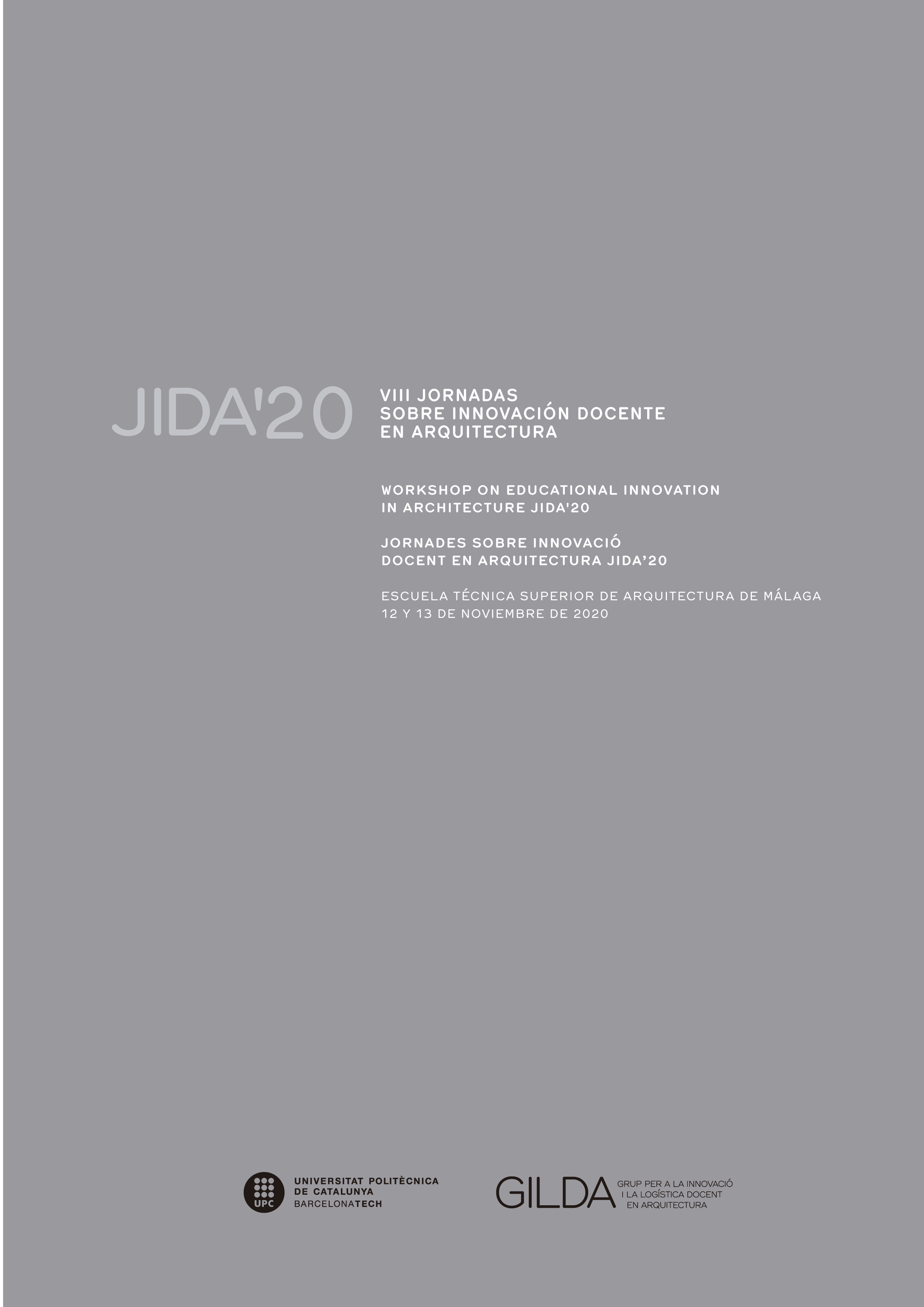Buildings 360º: a new approach to teaching construction
DOI:
https://doi.org/10.5821/jida.2020.9333Abstract
We present here the innovative education project Buildings 360⁰. This project follows previous educative initiatives. The project goal is to develop a novel immersive platform that will enable students to view real construction works along time. This platform will use 360 images in contrast to the widespread and expensive 3D models resulting into a low-cost system which is at the same time very intuitive, allows to manage large amounts of data and is easy to implement by non-expert users. This system will be used as a complementary material in the subjects of Construction I and II and will enable students to look up each of the phases of the construction work, the materials and the construction systems.
References
CASTRONOVO, F., NIKOLIC, D., MASTROLEMBO VENTURA, S., AKHAVIAN, R., GAEDICKE, C. y YILMAZ, S. (2019). “Design and Development of a Virtual Reality Educational Game for Architectural and Construction Reviews†en American Society for Engineering Education Annual Conference & Exposition. Tampa. Disponible en: <https://www.asee.org/public/conferences/140/papers/24588/view> [Consulta: 2 de septiembre de 2020].
FRY, R. y KOLB, D. (1979). “Experiential learning theory and learning experiences in liberal arts education†en New directions for experiential learning, vol 6, issue 1, pp. 79-92.
MCCARTHY, B. (1982). "Improving Staff Development through CBAM and 4MAT" en Educational
Leadership, vol. 40, issue 1, pp. 20–25.
OVANDO VACAREZZA, G y ORTA RIAL, M. B. (2010). Memoria Practicum del Curso de Formación Inicial del Profesorado en el marco del Espacio Europeo de Educación Superior. Anexo 2. Estilos de aprendizaje. Practicum. Madrid: Universidad Politécnica de Madrid.
<http://oa.upm.es/47811 > [Consulta: 2 de septiembre de 2020].
REDONDO DOMÃNGUEZ, E.; FONSECA ESCUDERO, D.; SÃNCHEZ RIERA, A. y NAVARRO DELGADO, I. (2014). “Mobile learning en el ámbito de la arquitectura y la edificación. Análisis de casos de estudio†en Universities and Knowledge Society Journal, vol. 11(1), pp. 152-174.
<http://dx.doi.org/10.7238/rusc.v11i1.1844> [Consulta: 2 de septiembre de 2020].
REDONDO DOMÃNGUEZ, E.; FONSECA ESCUDERO, D. y NAVARRO DELGADO, I. (2017a). “Formación de urbanistas usando realidad aumentada y tecnologÃas de aprendizaje móvil†en Revista Iberoamericana de Educación a Distancia, vol. 20(2), pp. 141-165.
<https://doi.org/10.5944/ried.20.2.17675> [Consulta: 2 de septiembre de 2020].
REDONDO DOMÃNGUEZ, E.; VALLS, F. y VILLAGRASA, S. (2017b). “Technological adaptation of the student to the educational density of the course. A case study: 3D architectural visualization†en Computers in Human Behaviour, vol. 72, pp. 599-611.
<https://doi.org/10.1016/j.chb.2016.05.048> [Consulta: 2 de septiembre de 2020].
RODRÃGUEZ-GONZÃLVEZ, P.; GARCÃA-PERALO, E.; OLIVEIRA, D. y RODRÃGUEZ-MARTÃN, M. (2019). “DIGITAL MODELS OF STONE SAMPLES FOR DIDACTICAL PURPOSES†en CIPA 2019. Avila. Disponible en: <https://www.int-arch-photogramm-remote-sens-spatial-inf-sci.net/XLII-2-W15/1007/2019/> [Consulta: 2 de septiembre de 2020].
RODRÃGUEZ-MARTÃN, M. y RODRÃGUEZ-GONZÃVEZ, P. (2019). Materiales formativos 3d desde ingenierÃa inversa para el aprendizaje en materia de inspección de soldaduras. DYNA, Vol. 94(3), pp. 238-239.
<http://dx.doi.org/10.6036/8798> [Consulta: 2 de septiembre de 2020].
SÃNCHEZ-APARICIO, L. J.; MORENO-BLANCO, R.; MARTÃN-JIMÉNEZ, J. A.; RodrÃguez-Gonzálvez, P.; MUÑOZ-NIETO, A. L.; y GONZÃLEZ-AGUILERA, D. (2019). “Smartwall: a new web-based platform for the valorization of the medieval wall of Ãvila†en CIPA 2019. Ãvila. Disponible en: <https://www.int-arch-photogramm-remote-sens-spatial-inf-sci.net/XLII-2-W15/1055/2019/> [Consulta: 2 de septiembre de 2020].
VEGA SÃNCHEZ, S.; PINILLA MELO, J.; y GARCÃA MORALES, S. (2017). “Proyecto de innovación educativa: ARCHITECT–Visitas de Obras†en JIDA´17 V Jornadas sobre Innovación Docente en Arquitectura. Sevilla. Disponible en <https://upcommons.upc.edu/handle/2117/109622> [Consulta: 2 de septiembre de 2020].
WESOÅOWSKI, Å. (2019). Virtual reality and BIM as a potential tool for architectural engineers’ education. World Transactions on Engineering and Technology Education, Vol. 17(4), pp.477-482.
<http://www.wiete.com.au/journals/WTE&TE/Pages/Vol.17,%20No.4%20(2019)/11-Wesolowski-L.pdf> [Consulta: 2 de septiembre de 2020].






















